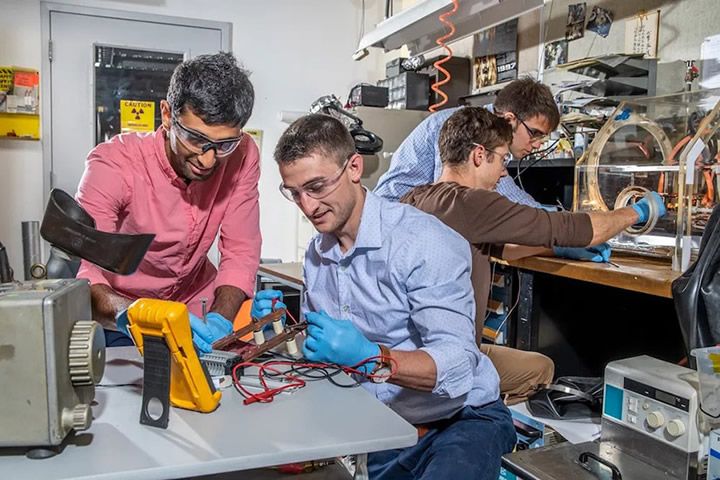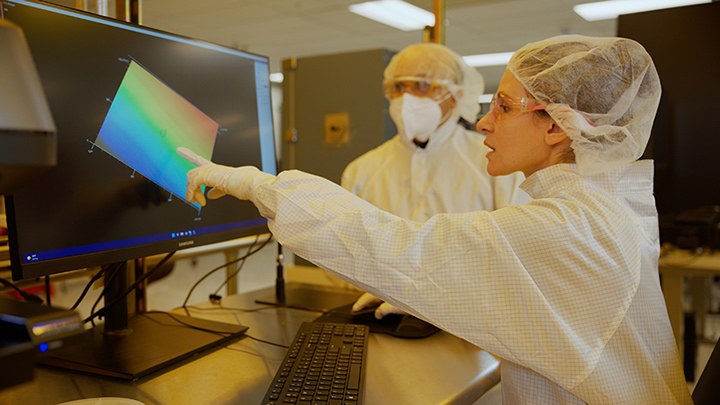To put it simply: Antora Energy, a startup focused on decarbonizing industry by converting low-cost, intermittent renewable electricity into reliable industrial energy, would not be where it is today without the help of the U.S. Department of Energy’s NREL.
 How NREL Helps Startups From the Beginning
How NREL Helps Startups From the Beginning

Jeffrey Wolf | NREL
To put it simply: Antora Energy, a startup focused on decarbonizing industry by converting low-cost, intermittent renewable electricity into reliable industrial energy, would not be where it is today without the help of the U.S. Department of Energy’s National Renewable Energy Laboratory (NREL).
“We got our first thermophotovoltaic (TPV) cells from NREL in 2018,” said Tarun Narayan, principal engineer at Antora. “Cells from NREL are among the most efficient TPV cells ever made. If we didn’t have NREL and we had to figure it out ourselves, we’d probably still be figuring it out.”
Antora is not alone in the sentiment.
“In the beginning, we had this new idea, but we had no money,” said Peter Luttik, former vice president of technology for 7AC Technologies and, after the company was acquired, now a consultant for Copeland. “With NREL’s help, investors knew that this was not just a bunch of guys in a garage.”
NREL and its corporate and philanthropic program-sponsor partners such as Wells Fargo, Chevron, and Shell often help startups like Antora and 7AC at their earliest stages so they can get off the ground and start the journey to bring disruptive technologies into the market. This often comes through programs offered by NREL’s Innovation and Entrepreneurship Center (IEC) and partnerships and license agreements managed by the Technology Transfer Office (TTO). It also occurs earlier in a startup’s development when NREL can validate emerging technologies, as NREL has experts on staff and maintains equipment that startups often cannot otherwise afford or access.
From 7AC to Emerson to Copeland
Before coming to NREL for assistance, 7AC, then named 7Solar, aimed to produce solar panels that could output both electricity and heat, using that heat to warm up water for homes and offices. However, as many startup journeys go, they took a sharp turn after gaining some experience in the market.
“Our investors wanted us to completely focus our very limited resources on developing and demonstrating desiccant heat exchangers,” Luttik said. “We had ideas on how to build internally cooled panels that could be reliably mass produced and demonstrated their feasibility.”
In 2010–2011, the founders of what is now Copeland looked at several NREL patented technologies, and that included liquid desiccants, which the company then licensed. This sort of assistance is something NREL often does, in addition to providing advice from NREL experts.

NREL engineer Eric Kozubal aids with HVAC research and often helps startups evaluate their technologies. Photo by Dennis Schroeder, NREL
“We helped 7AC define their product path of what they were going to design and build and develop,” said Eric Kozubal, NREL senior mechanical engineer and researcher. “We helped them along the way to engineer it, predict its performance, and to demonstrate it in the laboratory and then in the field.”
With this assistance, 7AC kept developing the liquid desiccant HVAC system and eventually participated in the Wells Fargo Innovation Incubator (IN2) program in 2017–2018. This provided funding and access to NREL experts to help the company upgrade its technology for better consistency. At the same time, 7AC caught the attention of Emerson, which is now working to scale the technology in the market.
How NREL Helps Startups
Licensing technology is a key way NREL helps form and grow startups. That licensing comes through the laboratory’s TTO.
“We provide access to innovations that you can’t get anywhere else,” said Eric Payne, TTO senior licensing executive. “A startup company armed with the license to national lab technology can go into the market and secure funding in a seed round because they have the lab’s stamp of validation. Now, the company can go out and raise money to further mature the technology to fruition.”
According to Payne, when cleantech startups partner with a national laboratory, they increase patent application filings. As a result, these startups are 67% more likely to increase their venture capital funding and increase their initial public offering valuations.
“A startup is more likely to take technology that is cutting edge or might have a market otherwise because they can really build a business around it,” TTO Director Anne Miller said. “It’s really gratifying to work with these organizations where somebody has put it all on the line to see a new technology introduced into the marketplace. They are making a huge commitment; they’ve staked a lot on getting this new venture going. It’s rewarding to help them be successful.”

Antora Energy went on to participate in NREL’s GCxN program after the early assistance from the lab. Photo from Antora Energy
The IEC also plays a critical role assisting startups by developing technology incubation programs and other approaches for public and private partners to gain access to de-risked solutions. In addition to IN2, the IEC oversees several initiatives that offer training and/or funds, including:
“Startups developing products and processes based on science and engineering advances are critical to the energy transition,” said Kate Moore, head of partnerships for the IEC. “Unlike other accelerators, we’re focused on helping companies develop and optimize their technologies.”
The Gift of Cells
After getting assistance from NREL in 2018, Antora participated in the GCxN program less than a year later. When NREL first provided TPV cells to Antora, the two formed a long-term partnership. Then they won an Advanced Research Projects Agency-Energy grant from the Department of Energy to work together over the next three years, improving the cells.

Antora now grows its TPV cells on larger, 4-inch wafers, allowing for more cells. Photo from Antora Energy
Antora’s thermal batteries use renewable energy to heat up blocks of carbon inside the battery to temperatures of above 2000°C, allowing the batteries to dispense stored heat, and that heat can also be converted back into electricity using the TPV cells.
“The GCxN funding was originally intended for Antora to scale up some of the work that NREL had started,” Narayan said. “The early work was done on small wafer pieces, which could grow a maximum of four cells. We commissioned a new reactor to start growing on full 2-inch wafers, eventually reaching a new maximum of 12 cells.”
Now, Antora grows its TPV cells on 4-inch wafers, allowing for more cells. Antora also opened the world’s first commercial-scale TPV manufacturing facility, with a capacity of 2 megawatts annually.
Why Helping Startups Matters
Startups face many challenges along the way to entering the market, commonly known as valleys of death. Each is treacherous, but the first ones, when startups are just getting up and running, can be the most difficult. This is why NREL’s assistance is so important.
“The whole premise is to disrupt the market,” Kozubal said. “Startups can be a very powerful way of introducing novel innovative technologies that just haven’t been developed enough for a large company to adopt. A startup can serve as a vehicle that can bring big changes in technology rather than incremental changes.”
Many organizations approach NREL based on its reputation for assisting startups, and that reputation matters to those in the industry as well.
“Someone from a national lab saying this is what we measured, and this is how we evaluated it,” Luttik said, “that tends to be taken more or less at face value.”
Once they begin working with NREL, startups discover that reputation is well earned.
“It was a privilege to work with NREL on developing some of our first cells,” said Leah Kuritzky, Antora’s head of PV operations. “NREL’s scientists are the experts in the field of high-efficiency, high-performance photovoltaics. It was a great partnership to have, especially for us, when you’re doing hard tech and needing help with laboratory work. It was a great way to start out.”
Learn more about partnering with NREL.
The content & opinions in this article are the author’s and do not necessarily represent the views of AltEnergyMag
Comments (0)
This post does not have any comments. Be the first to leave a comment below.
Featured Product

